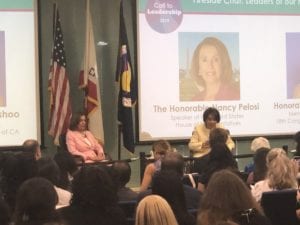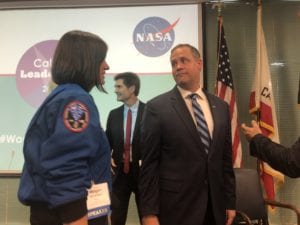Megan McArthur may be the first woman to “plant her boots on the moon” as she puts it, and she drew her inspiration from her childhood growing up on what is now NASA’s Ames Research Center in Mountain View.
“I grew up right here on Moffett Field Naval Air Station when it was still a Navy base, and as a teenager I watched the shuttle era astronauts come and park their 238 jets on the ramp and I thought, ‘That looks like a pretty great adventure,’” she told a crowd of hundreds Monday at NASA’s Ames Research Center in Mountain View during a celebration of Women Equality Day.


McArthur came back to NASA Monday to help introduce Nancy Pelosi, Speaker of the United States House of Representatives, who sat down for her own discussion around female leadership and innovation.
“Let me just say how important it is for all of you with your, shall we say, orientation towards technology and the future [of] STEM … to make your mark in all of this because the future is so … intimidating to some people because they don’t see their role, but it’s absolutely essential that women just totally show their stuff,” Pelosi told the crowd during a fireside chat-type discussion about “Leaders of our Nation.”
The event, in a modest, single-story building at federal research center filled with some of the most accomplished women in Silicon Valley and the country, was convened not only to celebrate Women Equality Day, but also to kick off a yearlong series by the Silicon Valley Leadership Group recognizing women leaders.
NASA was a logical partner to kick off the effort, said Carl Guardino, president and CEO of the Silicon Valley Leadership Group.
“If you’re going to aim for the stars, go to the people who actually do it,” Guardino said. “NASA has been such a great partner and member company for as long as I’ve been associated with the leadership group, being able to connect us with women astronauts and engineers and literally rocket scientists, has been an exciting addition to this effort.”
The Silicon Valley Leadership Group organized the day at NASA as the inaugural event of its series to commemorate the 100-year anniversary of women getting the right to vote, legislation passed in the House of Representatives in June 1919.
The day included a panel called Women in Innovation and another named Women Leaders Across Generations, each moderated and filled with some of the top women at local and national companies like Silicon Valley Bank, Ripple, eBay, AT&T, Genentech, NASA, Micron and the San Francisco 49ers.


But the headliner was undoubtedly the speech by McArthur and the “fireside chat” with Pelosi, the highest ranking woman in U.S. politics and second in line to the presidency.
During her discussion with Rep. Anna Eshoo, whose district includes Silicon Valley, Pelosi boasted about the strides made in the House of Representatives since her election in 1987. She’s watched the number of female representatives balloon from 23 three decades ago to 106 women today.
“Having more women in Congress is a decision,” Pelosi said. “Because we made a decision that every year we would increase the number. We would say ‘Get out there, run, do what you can do. We can help.’”
That’s a strong message to Silicon Valley, where women are still often the minority when it comes to leadership positions on boards and top-tier roles in companies. And surprisingly Silicon Valley has no female representatives in the state Capitol.
In California, 17.5 percent of Russell 3000 index company boards have no female directors, according to recent Equilar Gender Diversity Index (GDI) data. The Russell 3000 index includes the top 3,000 largest U.S.-traded stocks and includes many companies in the financial, health care and technology sectors.
That same data showed that as of March, 18.5 percent of all Russell 3000 director roles were held by women. Only 41 boards across the country had reached gender parity and seven of those were in California.
But the needle is moving in the right direction for women, the data shows, though there is still a long way to go to reach an equal number of men and women leaders.
At NASA, opportunities for women have changed dramatically in the past 50 years, Jim Bridenstine, administrator of the National Aeronautics and Space Administration, said Monday.


Five decades ago, “all of our astronauts were selected from fighter pilot backgrounds and test pilot backgrounds, and in those days there were zero opportunities for women,” he said. “But today at NASA we have a very diverse, highly qualified astronaut core that includes women.”
As of March, 64 women have flown in space, according to NASA data.
In business and in government, women add significantly to the conversation, offering new views, Pelosi said.
“It’s not just about what they would call the women’s issues,” she said. “It’s about our national security and women’s role in that, it’s about our economy, it’s about all of the subjects of the biggest magnitude in our country that women weigh in on and make a difference.”
Pelosi’s biggest advice to women looking to make that difference?
“Be yourself,” she said. “It’s so important for women to have the confidence, to have the courage to go out there and just jump into the arena.”
Meanwhile, McArthur, the woman astronaut who could be the first to land on the moon, is preparing to do just that.
In 2024, she could be part of NASA’s Artemis programm according to clues NASA has given out so far. That will be a mission to explore more of the moon than ever before using new technology, with the end goal of getting mankind — and womankind — to Mars.
“Whether it’s holding the American flag on the surface of the moon or the speaker’s gavel on the floor of the United States House of Representatives, it is of immeasurable value for our next generations to see women reshaping the globe, and our solar system beyond it,” McArthur said.
Check our website Wednesday for the second part of our coverage focusing on the two panels of women leaders.
Contact Janice Bitters at [email protected] or follow @JaniceBitters on Twitter.
Correction: This story has been updated to clarify that McArthur is one of the potential candidates to be the first woman on the moon, though the final decision by NASA hasn’t been announced.



Leave a Reply
You must be logged in to post a comment.